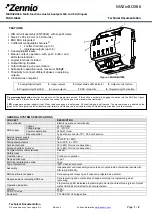
Horne Engineering Ltd
Issue 3 8/05
4
3.6.6 Remove the hot water inlet STRAINER CAP (16) at the inlet to the Horne 25
TMV. After initial draining of water, there should be no flow whatsoever. This
indicates that the check valve at the hot water inlet is giving a tight shut-off.
3.6.7 Replace the hot water inlet STRAINER CAP (16) and open the hot water isolating
valve.
3.7 The HORNE 25 TMV has now been commissioned.
4 TEMPERATURE ADJUSTMENT
4.1 The Horne 25 TMV is set at the factory to control the mixed water temperature at
approximately 42C.
4.2 The range of temperature adjustment is approximately
2
5C - 5
0
C. To alter the
temperature setting, carry out the following procedure :-
4.3 Check that the cold and hot water supplies are at or near to the ir designated
temperatures and pressure.
4.4 Open the mixed water outlet and allow water to flow until the mixed water
temperature has stabilised. Make sure that the dead leg from the HWS to the
HORNE 25 TMV and from the HORNE 25 TMV to the outlet has fully cleared.
4.5 Use the ADJUSTING KEY (1), turn the ADJUSTING SCREW (2) clockwise to
reduce the mixed water temperature or anti-clockwise to increase it. Adjustments of
not more that half a turn at a time should be made. The temperature at the outlet
should be measured and allowed to stabilise before any further adjustments are
made.
4.6 After making an adjustment, close the hot water supply isolating valve for 10
seconds then reopen it and measure the mixed water temperature again. If a further
adjustment is required, repeat the procedure.
5 IN-SERVICE TESTING
5.1 Periodic testing should be carried out to check whether any deterioration has
occurred in the performance of the HORNE 25 TMV.
5.2 A COLD WATER FAILURE TEST should be carried out as described in 3.5.1
above. If the water coming from the tap is at a temperature of more than 2C above
the mixed water temperature setting then the HORNE 25 TMV is due for
maintenance.
NOTE
: A Thermostatic Mixing Valve in need of maintenance can be undetectable
in normal use and only become apparent when a disruption occurs in the hot or cold
water supply pressures or temperatures.



























